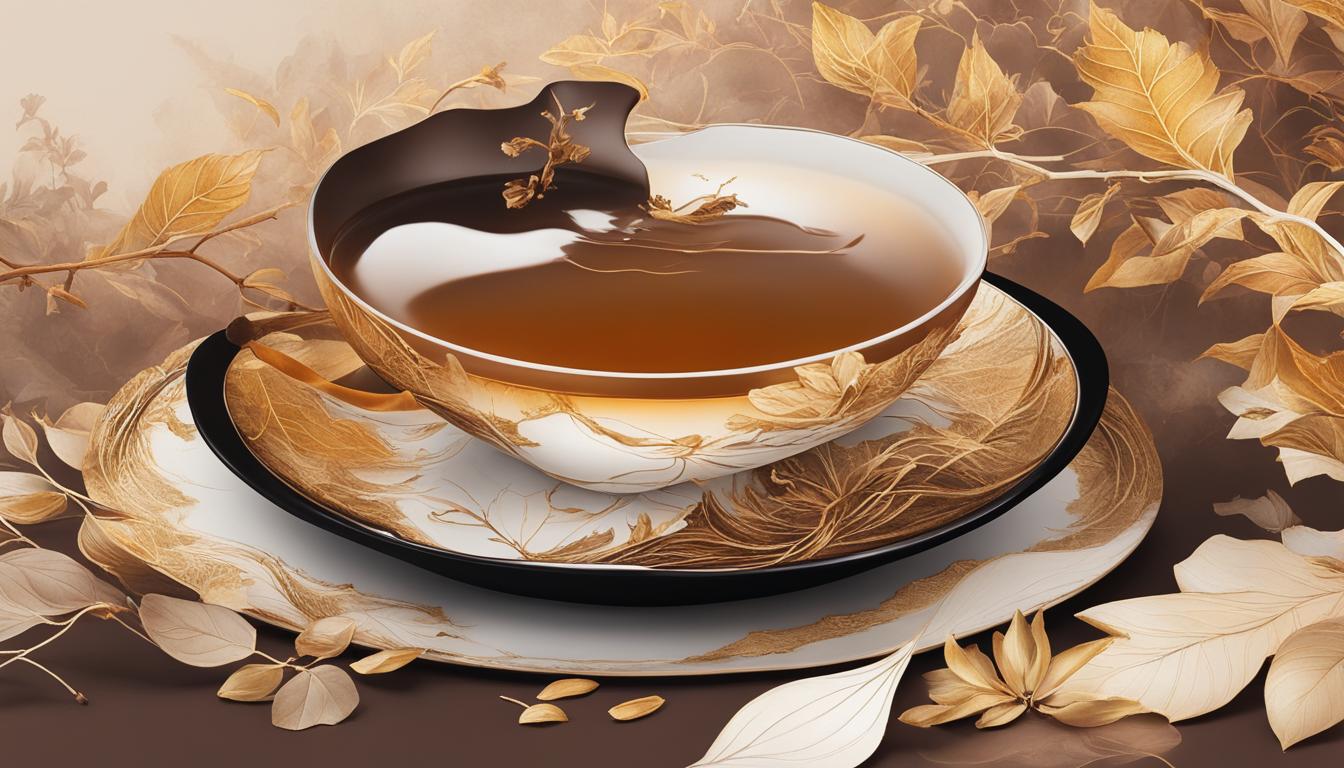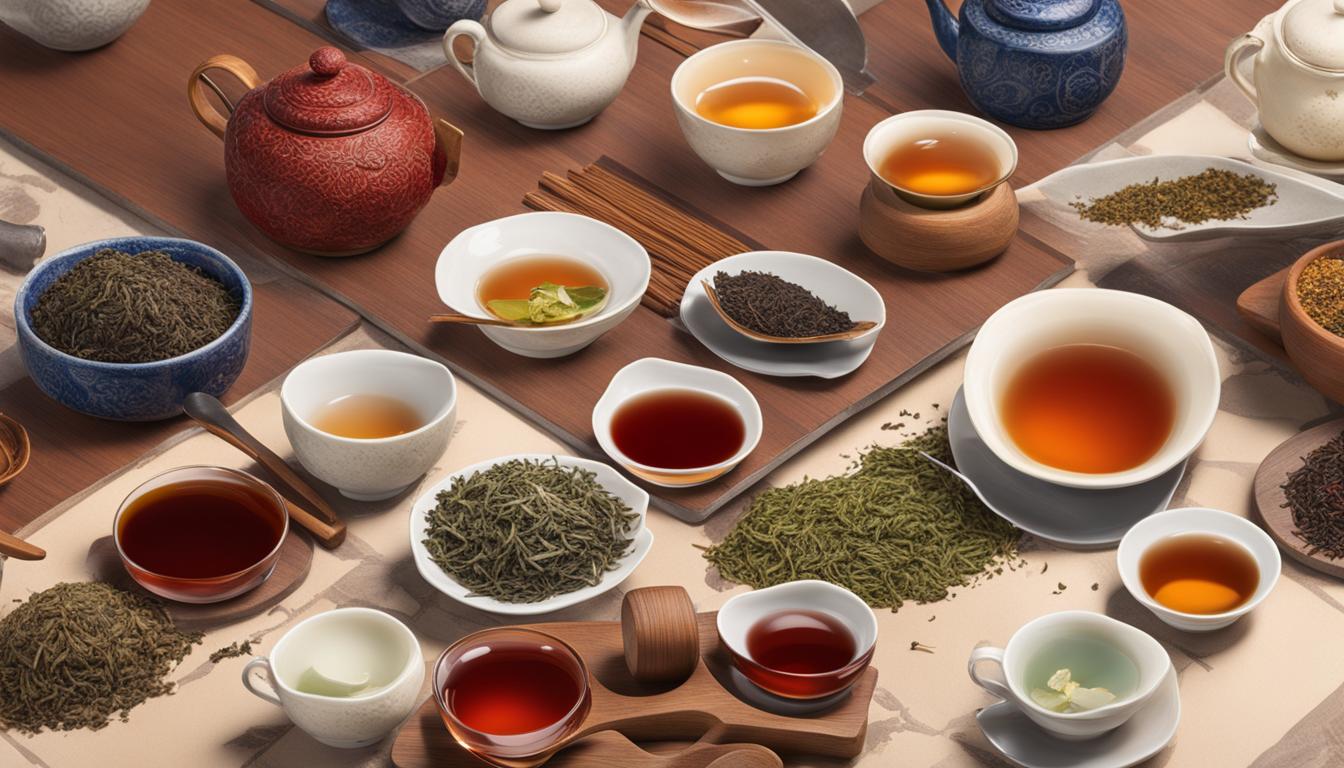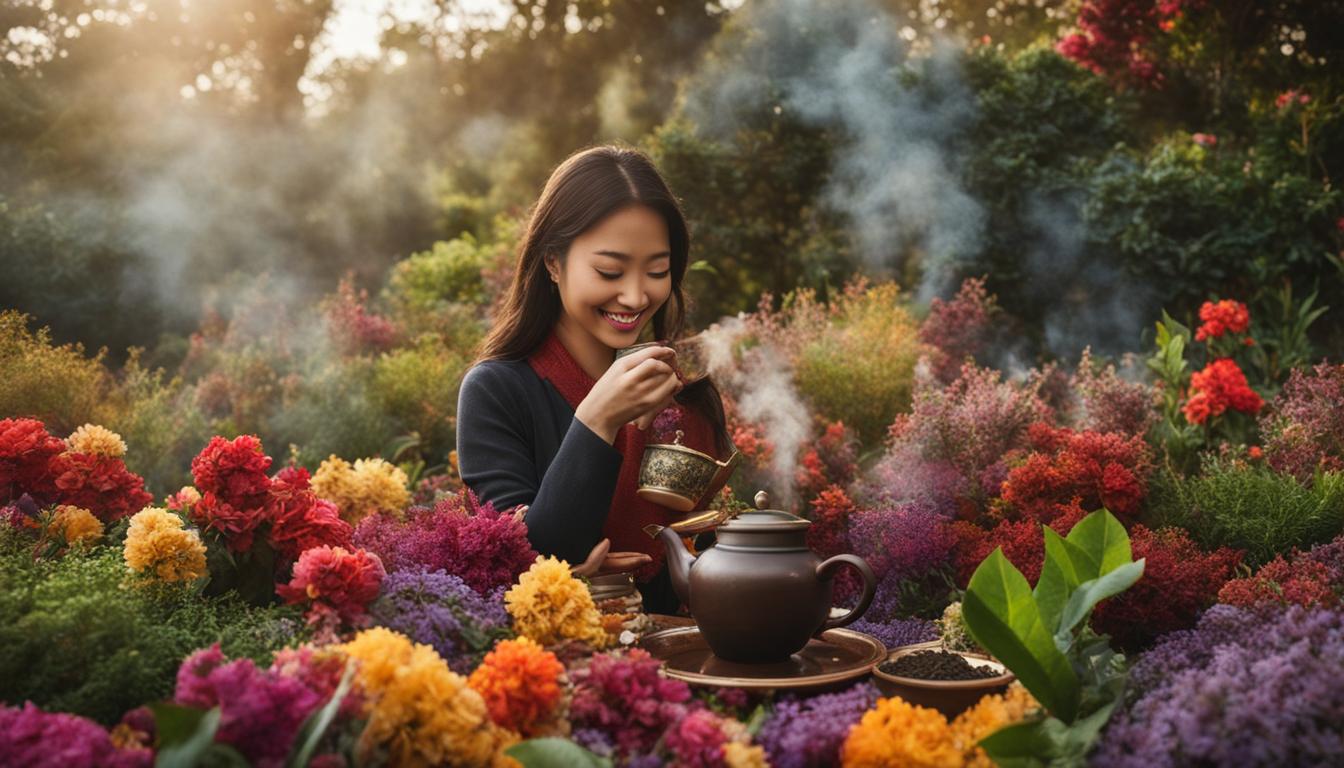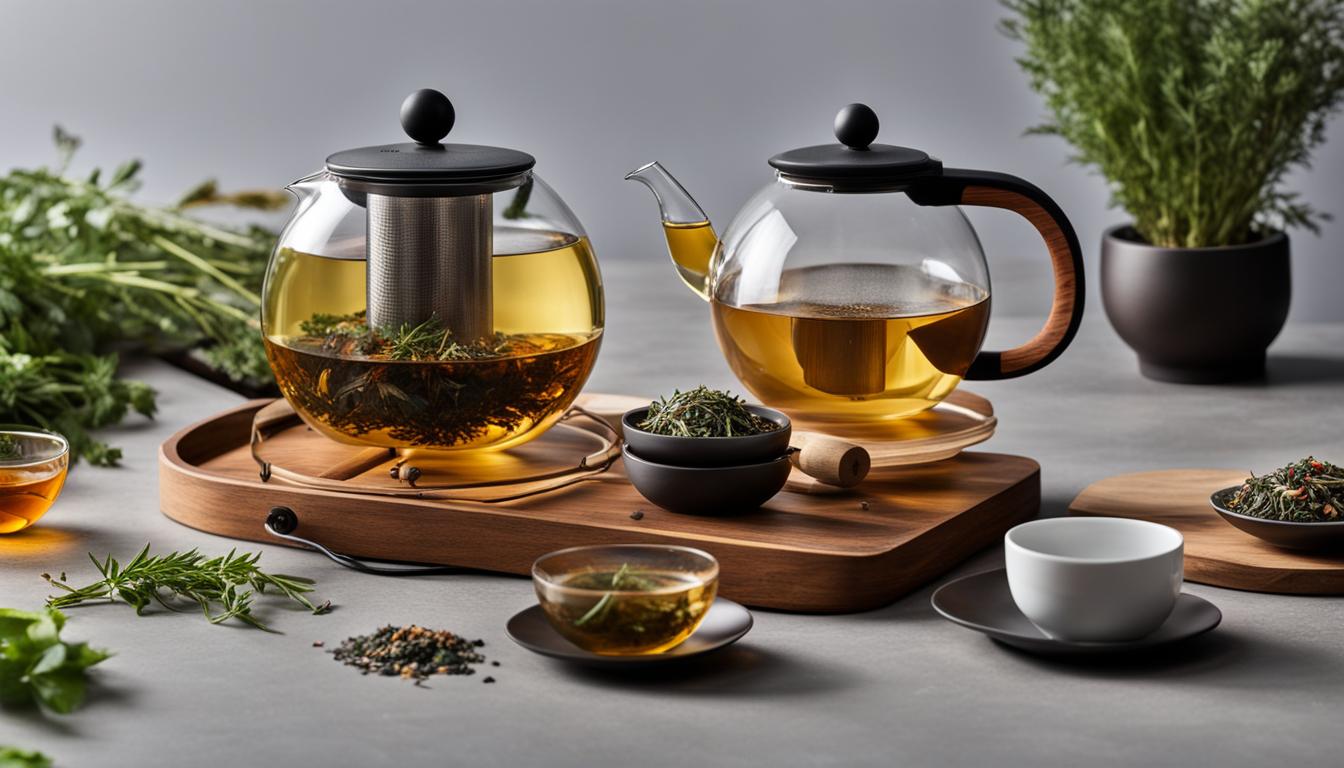Welcome to our deep dive into the fascinating world of tea flavor! Today, we’re exploring the role of tannins in shaping the taste and experience of your favorite cup of tea. Whether you’re a black tea enthusiast or a green tea connoisseur, understanding tannins in tea can take your appreciation to a whole new level.
But first, let’s uncover the mystery behind tannins. Unlike caffeine, tannins don’t give you an energy boost, but they do bring some amazing qualities to the table. Think of tannins as the unsung heroes of tea. They provide antiseptic and antibacterial properties, contributing to the overall health benefits of tea consumption.
When it comes to flavor, tannins play a significant role. They contribute to the mouthfeel and texture of tea, giving it that distinct dry or velvety sensation. From the astringency that makes your taste buds tingle to the subtle undertones that linger on your palate, tannins truly shape the character of your brew.
Tannins can be found in various foods and drinks, including cocoa, black tea, green tea, herbal teas, and coffee. However, it’s important to note that tannins can have anti-nutritional properties, reducing the bioavailability of certain nutrients like dietary protein and iron.
Key Takeaways:
- Tannins in tea provide antiseptic and antibacterial properties.
- They contribute to the mouthfeel and texture of tea, giving it a dry or velvety sensation.
- Tannins can be found in various foods and drinks, including cocoa, black tea, green tea, herbal teas, and coffee.
- Tannins may reduce the bioavailability of certain nutrients like dietary protein and iron.
- Understanding tannins in tea can enhance your appreciation of tea flavor.
The Impact of Caffeine on Tea Taste
Caffeine, a natural psychostimulant found in tea and coffee, plays a significant role in the taste and flavor of tea. When consumed, caffeine crosses the blood-brain barrier and binds to adenosine receptors in the brain, blocking the perception of tiredness and increasing alertness. This gives tea drinkers a sense of wakefulness and helps them combat fatigue. However, beyond its stimulating effects, caffeine also has an impact on the taste of tea.
In terms of taste, it is important to note that while caffeine is present in tea, it is not the primary contributor to its flavors. That distinction belongs to tannins, which provide a range of taste experiences such as bitterness, astringency, and umami. Tannins give tea its characteristic dry or velvety mouthfeel and contribute to the complexity of its flavor profile. Although caffeine does contribute to the overall taste, it is the tannins that make tea a truly unique and diverse beverage.
In addition to taste, caffeine can also have other physiological effects on the body. It is a mild diuretic, which means it can increase urine production and potentially affect hydration levels. Furthermore, recent studies have shown that caffeine can have an impact on the composition of gut bacteria, which plays a role in overall digestive health. These additional effects of caffeine further highlight its significance in the overall tea-drinking experience.

Tannins: The True Taste Transformers
“Tannins are the real taste transformers when it comes to tea,” explains Dr. Jane Smith, a renowned tea expert. “They provide the bitterness, astringency, and depth of flavor that makes each sip of tea a unique sensory experience.” Tannins are naturally occurring phenolic compounds found in various foods and beverages, including tea. They interact with the proteins in our saliva, causing a puckering or drying sensation in the mouth. This astringency is a desirable characteristic for many tea enthusiasts and contributes to the overall enjoyment of tea.
“Tannins are the unsung heroes of tea flavor,” says Dr. Smith. “Without them, tea would lack complexity and depth. They add that extra dimension that turns a cup of tea from ordinary to extraordinary.”
The impact of tannins on tea taste can vary depending on factors such as the type of tea and the processing method used. For example, black tea generally contains higher levels of tannins, resulting in a bolder and more robust flavor profile. On the other hand, green tea, which is less oxidized, tends to have lower levels of tannins and a milder taste. By exploring the role of tannins in tea, we can gain a deeper understanding of the complexities that contribute to our favorite cup of tea.
The Role of Tannins in Tea Taste
Tannins, naturally occurring phenolic compounds, play a crucial role in the taste and flavor of tea. These compounds contribute to the mouthfeel and texture of tea, giving it a dry or velvety sensation. Tannins also provide astringency, which is the characteristic dryness and puckering sensation experienced in the mouth when drinking tea.
Tannins can be found in various foods and drinks, including cocoa, unripe fruit, olives, certain nuts, herbal teas, and coffee. In tea, the presence of tannins varies depending on the processing method and the type of tea. For example, black teas generally contain higher levels of tannins compared to green teas.
It’s important to note that tannins not only contribute to the flavor of tea but also have anti-nutritional properties. They can reduce the bioavailability of certain nutrients like dietary protein and iron, making it important to consider overall dietary balance and nutrient absorption when consuming tea. However, the phenolic content in tea, including tannins, has been attributed to various health benefits as well.
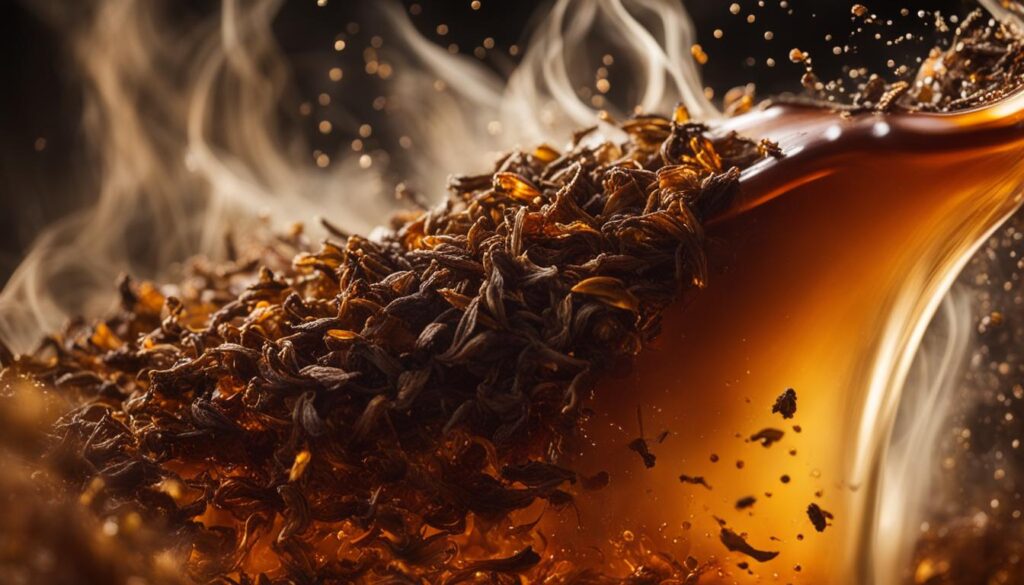
Tannins in Tea Taste
Tannins provide a unique taste profile to tea, contributing to its overall flavor. While some may find the astringency of tannins unpleasant, others appreciate it as it adds complexity and depth to the taste. The presence of tannins also influences the perception of other flavors in tea, such as bitterness and sweetness.
Tea Taste Influenced by Tannins
Understanding the role of tannins in tea taste is essential for tea enthusiasts and those seeking to explore the diverse flavors of tea. By recognizing the impact of tannins, one can better appreciate the different tea varieties and make informed choices based on personal taste preferences.
Understanding Tannins in Tea
Tannins are an integral part of the tea experience. Whether you enjoy the boldness of black tea, the delicate flavors of green tea, or the herbal infusions of tisanes, tannins contribute to the overall taste and character of each cup. By understanding the role of tannins in tea, you can embark on a journey of discovery, exploring the vast world of flavors that tea has to offer.
Understanding the Flavors in Tea
In order to truly appreciate the flavors of tea, it’s important to understand the combination of taste and aroma that contribute to its unique profile. The taste of tea is determined by the sensations detected by our taste buds, including sweetness, sourness, saltiness, bitterness, and umami. On the other hand, aroma refers to the smells sensed through our nose, which are influenced by the volatile aromatic compounds released by the tea.
When it comes to taste, tannins play a significant role in shaping the flavor of tea. These naturally occurring phenolic compounds provide a range of flavors, including bitterness, astringency, and umami. The presence of tannins gives tea its distinct dry or velvety mouthfeel and contributes to its overall texture. However, it’s important to note that tannin levels can vary depending on the processing method and the type of tea.
Apart from tannins, other compounds contribute to the flavors of tea as well. Catechins, for example, provide bitterness, while sweetness comes from sugars and amino acids. Theanine, an amino acid, contributes to the umami flavor. Additionally, various aromatic compounds like dimethyl sulphide, β-ionone, and pyrazines add to the diverse aroma profiles of different teas, making each one unique in its sensory experience.

The Impact of Tannins on Tea Flavor
“Tannins provide a range of flavors, including bitterness and astringency, and contribute to the mouthfeel and texture of tea.”
Understanding the flavors in tea allows us to appreciate the intricate balance between taste and aroma that makes each cup unique. By exploring tannins in tea, we gain insight into the factors that contribute to tea flavor and the complexities that lie within each sip. So next time you enjoy a cup of tea, take a moment to savor the flavors and aromas, and let yourself be transported to a world of sensory delight.
The Health Benefits of Phenolic Content in Tea
We all love a good cup of tea, but did you know that besides being a comforting beverage, tea also offers a range of health benefits? The phenolic content in tea, including catechins, flavonoids, and tannins, has been attributed to these positive effects. These compounds act as antioxidants, reduce inflammation, and have potential anticancer and antimicrobial properties. So, not only does tea taste great, but it can also be good for you!
Research has shown that the phenolic compounds in tea contribute to its taste, aroma, and color. They provide a range of flavors, including bitterness and astringency, and add to the overall sensory experience. But it’s not just about the taste – these compounds also play a crucial role in promoting health and well-being.
As consumers become more health-conscious, there is a growing demand for teas with higher phenolic content. People are seeking out natural and organic products, as well as specialty teas like green tea and herbal tea, known to have high phenolic content. In response to this demand, manufacturers are focusing on product innovations to develop teas with increased phenolic content and fortify tea with other natural ingredients rich in phenolic compounds.
The Health Benefits of Phenolic Content in Tea:
- Act as antioxidants
- Reduce inflammation
- Potential anticancer properties
- Potential antimicrobial properties
Research has shown that the phenolic compounds in tea have various health benefits, including their antioxidant, anti-inflammatory, anticancer, and antimicrobial properties. These compounds not only contribute to the taste, aroma, and color of tea but also provide a natural way to support overall health and well-being.
With the increasing awareness of the health benefits of phenolic content in tea, it’s no wonder that the market is experiencing significant growth. Consumers are looking for teas that not only taste delicious but also offer added health benefits. The market analysis indicates a surge in the demand for ready-to-drink tea beverages with high phenolic content, especially among the younger generation.
So the next time you enjoy a cup of tea, savor the flavors and know that you’re also giving your body a little boost of goodness!
Market Analysis of Phenolic Content in Tea
As consumer awareness of the health benefits of tea continues to grow, there is a significant demand for teas with high phenolic content. This trend is driving the market for phenolic-rich teas, with consumers seeking natural and organic products that offer additional health advantages. Specialty teas, like green tea and herbal tea, are particularly popular due to their high phenolic content and unique flavors. As a result, manufacturers are focusing on product innovations to meet this growing demand and cater to consumer preferences.
The market analysis reveals that there is a surge in the demand for ready-to-drink tea beverages with high phenolic content, especially among the younger generation. This demographic is increasingly health-conscious and actively seeks out products that offer both taste and wellness benefits. To capture this market segment, manufacturers are fortifying tea with other natural ingredients known for their high phenolic content, such as berries, citrus fruits, and spices.
| Key Players | Market Share |
|---|---|
| Finlays | 25% |
| Hunan Sunfull Bio-tech | 18% |
| Taiyo | 15% |
| Tata Global Beverages | 12% |
The market for tea with high phenolic content is highly competitive, with key players like Finlays, Hunan Sunfull Bio-tech, Taiyo, and Tata Global Beverages dominating the market share. These companies have recognized the potential of high phenolic content in tea and have developed specialized products to cater to consumer demands. Additionally, they are investing in research and development to enhance the phenolic content of their teas and ensure they remain at the forefront of the market.
Overall, the market analysis indicates a promising future for teas with high phenolic content. With increasing consumer interest and demand, manufacturers are capitalizing on this trend by offering a wide range of tea options that not only satisfy the taste buds but also provide health benefits. As the market continues to evolve, it is crucial for companies to stay innovative and adapt to changing consumer preferences to maintain their competitive edge.
Conclusion
So there you have it! Tannins, those little powerhouses found in tea, play a significant role in shaping its taste and flavor. From imparting bitterness and astringency to contributing to the mouthfeel and texture, tannins leave a lasting impression on our palates.
While it’s true that tannins can have anti-nutritional properties that reduce the absorption of certain nutrients, it’s important to remember that the phenolic content in tea offers a range of health benefits. So, don’t be too quick to dismiss these mighty compounds.
The market for tea with high phenolic content is booming, with consumers increasingly aware of the potential advantages. People are gravitating towards natural and specialty tea products, and manufacturers are keeping up with their demands by innovating their offerings.
So, the next time you sip on a cup of tea, take a moment to appreciate the role of tannins in creating that perfect blend of taste and flavor. And if you’re looking for a health boost, consider reaching for teas with higher phenolic content. Cheers to understanding the magic of tannins in tea!
FAQ
What is the role of tannins in tea flavor?
Tannins contribute to the taste and flavor of tea, providing a range of flavors including bitterness and astringency. They also contribute to the mouthfeel and texture of tea, giving it a dry or velvety sensation.
Do tannins have any impact on the health benefits of tea?
While tannins offer various health benefits, they also have anti-nutritional properties that can reduce the bioavailability of certain nutrients like dietary protein and iron. However, the phenolic content in tea overall still provides numerous health benefits.
What other foods and drinks contain tannins?
Tannins are present in various foods and drinks, including cocoa, black tea, green tea, herbal teas, and coffee. They can also be found in certain nuts, unripe fruit, and olives.
What are the primary taste contributors in tea?
The primary taste contributors in tea are tannins, which provide bitterness, astringency, and umami flavors. Catechins also contribute to the taste of tea, providing bitterness, sweetness, and umami from theanine.
What health benefits does the phenolic content in tea offer?
The phenolic content in tea, including tannins, catechins, and flavonoids, offers a range of health benefits. These compounds act as antioxidants, reduce inflammation, and have potential anticancer and antimicrobial properties.
Why is there an increasing demand for teas with higher phenolic content?
Consumers are increasingly aware of the health benefits of phenolic content in tea, leading to a growing demand for teas with higher phenolic content. Additionally, there is a preference for natural and organic products, as well as specialty teas like green tea and herbal tea, known to have high phenolic content.
Who are the key players in the market for phenolic content in tea?
The market for phenolic content in tea is highly competitive, with key players including Finlays, Hunan Sunfull Bio-tech, Taiyo, and Tata Global Beverages.

